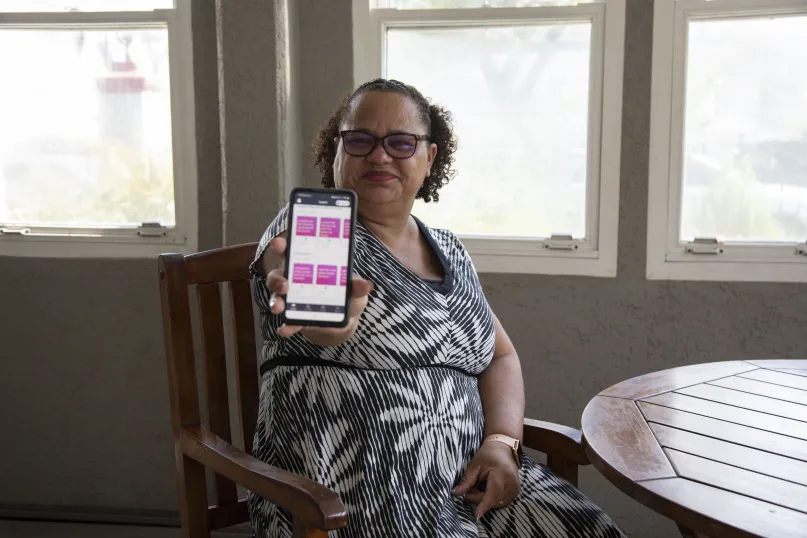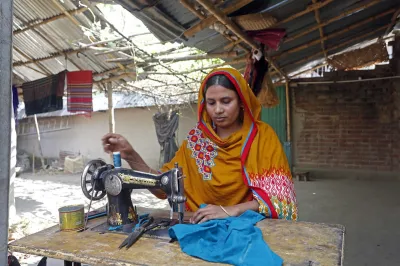Bridging the Divide: Boosting Women Entrepreneurs’ Digital Access for Financial Inclusion

The Cherie Blair Foundation for Women, in partnership with Intuit, has released new research that reveals the ‘lay of the land’ for women entrepreneurs in low and middle income countries – including challenges and opportunities that strongly impact on their financial inclusion. We found that digital inclusion is essential for achieving financial inclusion for these women entrepreneurs, and concerted efforts are needed from various sectors to address challenges and create opportunities for economic empowerment.
Digital inclusion leads to financial inclusion - but women lack connectivity
These days, digital and financial inclusion go hand-in-hand. Banking increasingly takes place on the web, digital payments are more and more so the norm, and financial literacy is frequently built via interaction with online content and tools. It works both ways too – financial inclusion enables access to the technology needed to participate in much of the modern world.
This rings especially true for women entrepreneurs. The odds are often stacked against women when it comes to being able to access the financial products and tools they need to grow their businesses, but digital tools, training, and support offer routes to overcome these challenges. However, in many low and middle income countries, a lack of connectivity puts women on an uneven playing field, preventing them from accessing the finance needed for business success.
Accessing finance remains the number one challenge
Last year, over 1,100 women entrepreneurs across 81 low and middle income countries shared their experiences around digital inclusion and access to finance with the Cherie Blair Foundation for Women. Their responses formed our new research report with Intuit, ‘Bridging the Divide: Women, Technology and Business Success’.
It won’t surprise anyone that accessing finance remains a huge issue for women entrepreneurs. This was by far their biggest challenge, as reported by a quarter of the women (25.6%), followed by the macroeconomic environment (13.3%), and retaining customers (11.4%).
When asked about ways to address these challenges, the top response was a clear need for financial support (without the expectation of returns), at 80.4%, followed by financial investment, at 47.7%. Nearly half (46%) also requested skills or training, many of which link directly to the use of financial tools and technology.
“This all points to a clear problem: in short, women entrepreneurs need money – and they aren’t getting it.”
For a range of gendered and structural reasons, many women are unable or even reluctant to pursue the finance they need in the digital age. They may lack the financial and digital literacy or know-how, the technology, or the documentation and collateral they need to access finance, or experience gender norms or societal biases that stand in their way.
Meanwhile, business finance remains strongly geared toward men, with gender bias baked into products and services, and openly held gender stereotypes causing doors to shut in women’s faces. In many LMICs, financial services are seen as untrustworthy and ‘getting into the system’ is often perceived as a double-edged sword for women running informal, cash-based businesses. All in all, this makes for a pretty challenging landscape for women entrepreneurs in LMICs – one that, as we progress increasingly into a tech-enabled business world, will only become more out of reach unless action is taken.
When women have greater access to finance, they spend it on tech
Women need business capital – but what are they spending it on when they receive it? Those we surveyed flagged a significant reliance on digital tools for business, with 92.1% reporting high internet usage, largely on smartphones. Nearly a quarter (24.4%) of women attributed business success to increased digital inclusion and a third (32.8%) to improved access to business networks, including virtual. The growing importance of digital platforms, connectivity, and e-commerce as tools for business is clear.
It’s no wonder, therefore, that women entrepreneurs’ technology-related spending is increasing: 54.1% told us they intend to spend more on digital tools for business than the previous year, projecting 37.2% growth in 2024 for an already USD 30 billion market.
Despite this, more than four in 10 (41.9%) respondents stated that they lack the time and money to keep up with changes and developments in online tools – another gendered challenge as women tend to be less wealthy and more time-poor than men. The cost of simply being online is also a huge barrier, as 69.1% of the women reported. Considering just how frequently transactions, banking, and other business activities happen online these days, this is a critical issue.
Building women’s digital capacity enables them to use fintech
Fintech has revolutionized financial services this century. Indeed, 96.7% of the women we surveyed rated using digital tools to manage finances as “very important”. Given women entrepreneurs’ reported need for training and support, it’s clear that building their capacity to use digital tools is a surefire way to advance their financial inclusion by enabling them to use services like mobile banking, digital payments, and online lending platforms.
These fintech tools can hugely strengthen women’s businesses, allowing them to streamline their financial operations, manage cash flows more efficiently, and access customers and capital. And what better way to build women’s capacity for using online tools and apps than online and app-based training? Never has it been clearer: a smartphone puts financial inclusion at your fingertips, particularly if you are a woman entrepreneur in a low or middle-income country.
Emerging tech: A double-edged sword
While fintech and emerging digital tools like AI are vital tools for women entrepreneurs, they can also put them at risk. We know that the world is less safe for women, and digital spaces are no exception. It was sobering to see that almost seven out of 10 (67.4%) women reported personally witnessing or experiencing online gender-based violence – things like harassment, stalking, and exploitation – over the past year alone. Disturbingly, nearly half (45.4%) told us that these instances had impacted the success of their businesses. Is it any wonder, then, that some women may be reluctant to step into the world of online banking and business?
Turning the tide in the digital economy
These issues aren’t going away any time soon. With a massive expansion in digital uptake and threats like an unfavorable macroeconomic environment, without urgent action, women entrepreneurs stand to be further frozen out of finance and held back from running successful businesses.
One answer is to create more cross-sectoral, women-centered partnerships. Policymakers, the public sector, business leaders, and civil society must collaborate to ensure women have what they need. This includes access to digital financial services, gender-specific programs that support women to adopt these services, boost their financial and digital literacy and access to finance, and safe online spaces to network and conduct business.
The private sector has a key role to play in helping close the gender gap in entrepreneurship and address the issues that perpetuate it. One way they can do this is by designing financial products and services that truly meet women’s needs and unique situations.
By championing women's financial inclusion, the private and public sectors, and civil society can not only drive economic growth but also pave the way for a more just and equitable society. Let us seize this opportunity to empower women entrepreneurs and create a future where every woman has the opportunity to thrive.
Download our full research report to read our findings and recommendations in full.


